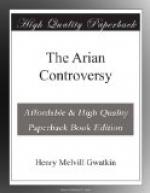[Sidenote: Council of Milan (Oct. 355).]
There was a sort of armed truce for the next two years. Liberius of Rome disowned the weakness of his legates and besought the Emperor to hold a new council. But Constantius was busy with the barbarians, and had to leave the matter till he came to Milan in the autumn of 355. There Julian was invested with the purple and sent as Caesar to drive the Alemanni out of Gaul, or, as some hoped, to perish in the effort. The council, however, was for a long time quite unmanageable, and only yielded at last to open violence. Dionysius of Milan, Eusebius of Vercellae, and Lucifer of Calaris in Sardinia were the only bishops who had to be exiled.
[Sidenote: Lucifer of Calaris.]
The appearance of Lucifer is enough to show that the contest had entered on a new stage. The lawless tyranny of Constantius had roused an aggressive fanaticism which went far beyond the claim of independence for the church. In dauntless courage and determined orthodoxy Lucifer may rival Athanasius himself, but any cause would have been disgraced by his narrow partisanship and outrageous violence. Not a bad name in Scripture but is turned to use. Indignation every now and then supplies the place of eloquence, but more often common sense itself is almost lost in the weary flow of vulgar scolding and interminable abuse. He scarcely condescends to reason, scarcely even to state his own belief, but revels in the more congenial occupation of denouncing the fires of damnation against the disobedient Emperor.
[Sidenote: Hilary of Poitiers.]
The victory was not to be won by an arm of flesh like this. Arianism had an enemy more dangerous than Lucifer. From the sunny land of Aquitaine, the firmest conquest of Roman civilization in Atlantic Europe, came Hilary of Poitiers, the noblest representative of Western literature in the Nicene age. Hilary was by birth a heathen, and only turned in ripe manhood from philosophy to Scripture, coming before us in 355 as an old convert and a bishop of some standing. He was by far the deepest thinker of the West, and a match for Athanasius himself in depth of earnestness and massive strength of intellect. But Hilary was a student rather than an orator, a thinker rather than a statesman like Athanasius. He had not touched the controversy till it was forced upon him, and would much have preferred to keep out of it. But when once he had studied the Nicene doctrine and found its agreement with his own conclusions from Scripture, a clear sense of duty forbade him to shrink from manfully defending it. Such was the man whom the brutal policy of Constantius forced to take his place at the head of the Nicene opposition. As he was not present at Milan, the courtiers had to silence him some other way. In the spring of 356 they exiled him to Asia, on some charge of conduct ‘unworthy of a bishop, or even of a layman.’
[Sidenote: Hosius and Liberius.]




